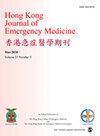Effect of shoulder positioning on ultrasonic visualisation of the subclavian vein in healthy adults: A prospective observational study
IF 0.8
4区 医学
Q4 EMERGENCY MEDICINE
引用次数: 0
Abstract
Introduction: Ultrasound guidance is commonly used during central venous cannulation. Subclavian vein is a commonly chosen site, but previous studies found varying results in the ideal positioning of the shoulder for subclavian vein cannulation. The objective of this study is to determine which shoulder position results in the greatest cross-sectional area of the right subclavian vein for cannulation. Methods: In this prospective observational study, ultrasound was performed on healthy adult volunteers to visualise the right subclavian vein in three different shoulder positions: neutral, abduction and retraction. A blinded independent investigator measured the cross-sectional areas by computer software using planimetry method. Statistical analysis was performed by one-way repeated measures analysis of variance. Results: Forty-four adults participated in the study. The mean cross-sectional area of the right subclavian vein in shoulder neutral, abduction and retraction positions were 1.05 ± 0.33 cm2, 1.01 ± 0.31 cm2 and 0.82 ± 0.28 cm2, respectively. When compared to shoulder retraction, the cross-sectional areas were significantly increased in shoulder neutral (P < 0.01) and abduction (P < 0.01) positions. There was no significant difference between shoulder neutral and abduction position (P = 0.71). Conclusion: Positioning the shoulder in neutral or abduction results in the greatest cross-sectional area of the right subclavian vein and may be more ideal for ultrasound guided cannulation.肩部定位对健康成年人锁骨下静脉超声显像的影响:一项前瞻性观察研究
引言:超声引导在中心静脉插管过程中常用。锁骨下静脉是一个常见的选择部位,但先前的研究发现,在锁骨下静脉插管的理想肩部定位方面存在不同的结果。本研究的目的是确定哪种肩部位置导致右锁骨下静脉插管的横截面积最大。方法:在这项前瞻性观察性研究中,对健康成年志愿者进行超声检查,以观察三种不同肩部位置的右锁骨下静脉:中性、外展和回缩。一名盲法独立研究者使用平面测量法通过计算机软件测量横截面积。统计分析采用单因素重复测量方差分析。结果:44名成年人参与了这项研究。肩中性位、外展位和回缩位的右锁骨下静脉平均横截面积为1.05 ± 0.33 cm2,1.01 ± 0.31 cm2和0.82 ± 0.28 cm2。与肩部收缩相比,中性肩关节的横截面积显著增加(P < 0.01)和外展(P < 0.01)位置。肩中立位与外展位比较差异无统计学意义(P = 0.71)。结论:将肩部置于中立或外展位置可使右锁骨下静脉的横截面积最大,可能更适合超声引导插管。
本文章由计算机程序翻译,如有差异,请以英文原文为准。
求助全文
约1分钟内获得全文
求助全文
来源期刊

Hong Kong Journal of Emergency Medicine
EMERGENCY MEDICINE-
CiteScore
1.50
自引率
16.70%
发文量
26
审稿时长
6-12 weeks
期刊介绍:
The Hong Kong Journal of Emergency Medicine is a peer-reviewed, open access journal which focusses on all aspects of clinical practice and emergency medicine research in the hospital and pre-hospital setting.
 求助内容:
求助内容: 应助结果提醒方式:
应助结果提醒方式:


